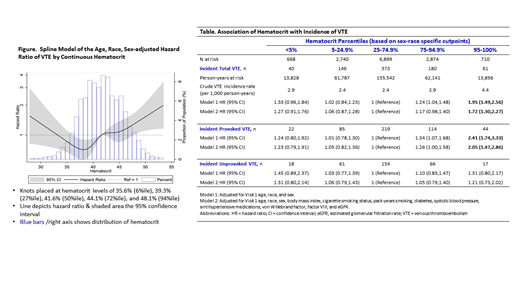Background. Polycythemia vera patients with high hematocrit have increased risk of venous thromboembolism (VTE). We tested whether high hematocrit in the general population is also associated with elevated VTE risk.
Methods. The prospective Atherosclerosis Risk in Communities (ARIC) Study performed a complete blood count in 13,891 adults aged 45-64 at baseline in 1987-89. We identified and validated incident hospitalized VTEs through 2015, with provoked VTE defined as occurring within 90 days of surgery, trauma, immobilization or with cancer. We performed proportional hazards regression analyses using race-sex specific categorization of hematocrit percentiles (i.e., <5, 5-24.9, 25-74.9, 75-94.9, and 95-100 percentiles, with the 25-74.9th percentile serving as the reference group).
Results. At baseline, higher hematocrit was associated with smoking prevalence, greater pack years smoked, higher body-mass index and higher prevalence of diabetes. With 26 years median follow-up, 800 participants had incident deep vein thrombosis of the leg and/or pulmonary embolism. The figure shows a J-shaped association of hematocrit with VTE incidence. The VTE incidence at the highest level of hematocrit was approximately double that at the mid level. Low hematocrit also was associated with elevated VTE incidence but the confidence interval overlapped 1. The Table shows modeling results. Accounting for other risk factors, the risk of overall VTE was elevated 72% for participants above the 95th percentile of hematocrit compared with the reference. Specifically, hazard ratios (95% confidence interval) of incident VTE were 1.27 (0.91,1.76), 1.06 (0.87,1.28), 1 (reference), 1.17 (0.98, 1.40) and 1.72 (1.30, 2.27) across the five hematocrit percentiles, adjusted for age, race, sex, body mass index, and other potential confounding variables including smoking status and pack-years. The association of high hematocrit with VTE was limited to provoked VTE, with little evidence for unprovoked VTE. Results were similar for hemoglobin (not shown).
Discussion. High hematocrit and hemoglobin in a general middle-aged population sample were associated with increased long-term risk of VTE, particularly provoked VTE. The reasons for this pattern require further study.
No relevant conflicts of interest to declare.
Author notes
Asterisk with author names denotes non-ASH members.


This feature is available to Subscribers Only
Sign In or Create an Account Close Modal